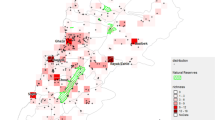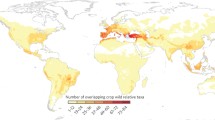Abstract
An efficient germplasm collecting method was evaluated using six Lupinus species and the Spanish Lupinus collection as a study case. This method includes the application of geographic information systems, ecogeographical land characterization maps, species distribution models and gap analysis to identify prioritized collecting sites. To evaluate the efficiency of this collecting method, field collecting expeditions were carried out focusing on prioritized sites and the results of these collections were analyzed. Prioritized sites were identified using spatial and ecogeographical gaps, and potential species richness maps. The spatial gaps corresponded to populations non-included in the collection but recorded by other information sources while ecogeographical gaps corresponded to spatial gaps that were located in ecogeographical categories (obtained from the ecogeographical map) that were scarcely represented in the collection. A potential Lupinus species richness map was obtained by adding the information of single maps of Lupinus species distribution models. Subsequently, prioritized sites were obtained in ecogeographical gaps with high potential species richness values. Collecting expeditions were made in Spain in 2006, 2007 and 2008. Results showed that using the efficient germplasm collecting methodology was highly positive not only from a quantitative viewpoint (between 7.8 and 11% increase) but also in qualitative terms, focusing collection efforts in ecogeographical categories with low or null representation in the Spanish Lupinus collection (41% of the new accessions). Phenotypic differences related to adaptation to environment were observed in the field between the populations that grow in low or null represented categories and those that grow in highly represented categories.





Similar content being viewed by others
References
Castroviejo S, Pascual H (1999) Lupinus. In: Talavera S, Aedo C, Castroviejo S, Romero Zarco C, Sáez L, Salgueiro FJ, Velayos M (eds) Flora iberica: plantas vasculares de la Península Ibérica e Islas Baleares, vol 7. Consejo Superior de Investigaciones Científicas, Madrid, pp 251–260
Cowling WA, Buirchell BJ, Tapia ME (1998) Lupin, Lupinus L. Institute of Plant Genetics and Crop Plant Research, Gatersleben; International Plant Genetic Resources Institute, Rome
FAO (2010) The second report on the state of the world`s plant genetic resources for food and agriculture. FAO, Rome
Fielding AH, Bell JF (1997) A review of methods for the assessment of prediction errors in conservation presence/absence models. Environ Conserv 24:38–49
French RJ, Sweetingham MW, Shea GG (2001) A comparison of the adaptation of yellow lupin (Lupinus luteus L.) and narrow-leafed lupin (L. angustifolius L.) to acid sandplain soils in low rainfall agricultural areas of Western Australia. Aust J Agric Res 52:945–954
Gladstones JS (1980) Recent developments in the understanding, improvement, and use of Lupinus. In: Summerfield RJ, Bunting AH (eds) Advances in legume science. Royal Botanical Gardens, Kew, pp 603–611
Greene SL, Hart TC (1999) Implementing a geographic analysis in germplasm conservation. In: Greene SL, Guarino L (eds) Linking genetic resources and geography: emerging strategies for conserving and using crop biodiversity. American Society of Agronomy; Crop Science Society of America, Madison, pp 25–38
Guarino L, Jarvis A, Hijmans R, Maxted N (2002) Geographic information systems (GIS) and the conservation and use of plant genetic resources. In: Engels JMM, Ramanatha Rao V, Brown AHD, Jackson MT (eds) Managing plant genetic diversity. CAB International, Wallingford, pp 387–404
Hamblin J, Delane R, Bishop A, Gladstones J (1986) Yield potential of reduced-branching lupins (Lupinus angustifolius) on sandy soils in a short season environment. Aust J Agric Res 37:611–620
Hijmans RJ, Schreuder M, De la Cruz J, Guarino L (1999) Using GIS to check co-ordinates of genebank accessions. Genet Resour Crop Evol 46:291–296
Hijmans RJ, Garrett KA, Huamán Z, Zhang DP, Schreuder M, Bonierbale M (2000) Assessing the geographic representativeness of genebank collections: the case of Bolivian wild potatoes. Conserv Biol 14:1755–1765
Hijmans RJ, Guarino L, Cruz M, Rojas E (2001) Computer tools for spatial analysis of plant genetic resources data: 1. DIVA-GIS. Plant Genet Resour Newsl 127:15–19
Hijmans RJ, Cameron SE, Parra JL, Jones PG, Jarvis A (2005) Very high resolution interpolated climate surfaces for global land areas. Int J Climatol 25:1965–1978
Huyghe C (1997) White lupin (Lupinus albus L.). Field Crops Res 53:147–160
Instituto Geográfico Nacional (1992) Atlas nacional de España, sección II, grupo 7. Edafología Instituto Geográfico Nacional, Madrid
Iriondo JM, Dulloo ME, Maxted N, Laguna E, Engels JMM, Maggioni L (2008) Final considerations for the in situ conservation of plant genetic diversity. In: Iriondo JM, Maxted N, Dulloo ME (eds) Conserving plant genetic diversity in protected areas. CAB International, Wallingford, pp 182–202
Jarvis A, Williams K, Williams D, Guarino L, Caballero PJ, Mottram G (2005) Use of GIS for optimizing a collecting mission for a rare wild pepper (Capsicum flexuosum Sendtn.) in Paraguay. Genet Resour Crop Evol 52:671–682
Landis JR, Koch GG (1977) The measurement of observer agreement for categorical data. Biometrics 33:159–174
Lane LA, Ayres JF, Lovett JV (2000) A white clover (Trifolium repens L.) ecotype collection from northern New South Wales, Australia. Plant Genet Resour Newsl 121:10–14
Larson MA, Millspaugh JJ, Thompson FR (2008) A review of methods for quantifying wildlife habitat in large landscapes. In: Millspaugh JJ, Thompson FR (eds) Models for planning wildlife conservation in large landscapes. Academic Press, Burlington, pp 225–250
Lázaro A, Campbell M, Francis C, Robertson L, de la Cuadra C (2002) Collecting biodiversity of important forage legumes in Spain. Plant Genet Resour Newsl 129:11–16
Maxted N, Dulloo E, Ford-Lloyd BV, Iriondo JM, Jarvis A (2008) Gap analysis: a tool for complementary genetic conservation assessment. Divers Distrib 14:1018–1030
Parra-Quijano M, Draper D, Iriondo JM (2007) GIS-based evaluation of the in situ conservation of a crop wild relative: the case of Spanish lupins. Bocconea 21:105–116
Parra-Quijano M, Draper D, Torres E, Iriondo JM (2008) Ecogeographical representativeness in crop wild relative ex situ collections. In: Maxted N, Ford-Lloyd BV, Kell SP, Iriondo JM, Dulloo ME, Turok J (eds) Crop wild relative conservation and use. CAB International, Wallingford, pp 249–273
Parra-Quijano M, Iriondo JM, Torres E (2011) Ecogeographical land characterization maps as a tool for assessing plant adaptation and their implications in agrobiodiversity studies. Genet Resour Crop Evol. doi:10.1007/s10722-011-9676-7
Pascual H (1986) Altramuces de la Península Ibérica e Islas Baleares. Taxonomía, área, autoecología, aprovechamiento y aspectos agronómicos. Instituto Nacional de Investigaciones Agrarias, Madrid
Phillips SJ, Anderson RP, Schapire RE (2006) Maximum entropy modeling of species geographic distributions. Ecol Model 190:231–259
Rabus B, Eineder M, Roth A, Bamler R (2003) The shuttle radar topography mission–a new class of digital elevation models acquired by spaceborne radar. ISPRS-J Photogramm Remote Sens 57:241–262
Rahman MS, Gladstones JS (1974) Effects of temperature and photoperiod on flowering and yield components of lupin genotypes in the field. Aust J Exp Agric Anim Husb 14:205–213
Ramirez-Villegas J, Khoury C, Jarvis A, Debouck D, Guarino L (2010) A gap analysis methodology for collecting crop genepools: a case study with Phaseolus beans. PLoS ONE 5:e13497. doi:10.1371/journal.pone.0013497
Segura S, Coppens d’Eeckenbrugge G, López L, Grum M, Guarino L (2003) Mapping the potential distribution of five species of Passiflora in Andean countries. Genet Resour Crop Evol 50:555–566
Simpson MJA, McGibbon R (1982) White lupin in cultivation in Iberia. Econ Bot 36:442–446
SPSS (2003) SPSS base 12.0 user’s guide. SPSS Inc, Chicago
Sujak A, Kotlarz A, Strobel W (2006) Compositional and nutritional evaluation of several lupin seeds. Food Chem 98:711–719
Acknowledgments
This work was funded by INIA (Ministry of Science and Innovation) project RF2004-00016-00-00. The authors thank all CRF-INIA personnel and UPM Plant Biology Department who supported collecting activities. We also thank Lori de Hond for her linguistic assistance.
Author information
Authors and Affiliations
Corresponding author
Rights and permissions
About this article
Cite this article
Parra-Quijano, M., Iriondo, J.M. & Torres, E. Improving representativeness of genebank collections through species distribution models, gap analysis and ecogeographical maps. Biodivers Conserv 21, 79–96 (2012). https://doi.org/10.1007/s10531-011-0167-0
Received:
Accepted:
Published:
Issue Date:
DOI: https://doi.org/10.1007/s10531-011-0167-0




